Tunnelizing Migration 4: An Exploration in Void Reclamation

[Image: A Practice in Excavating and Envisioning Ambos Nogales, by Edwin Agudelo, 2008, UC Berkeley, Dept.of Arch. / US-Mexico Border Wall as Architecture.]
Several months ago Ron Rael invited me to show some slides and talk about my obsession with the border to his students for an arch studio he was teaching at UC Berkeley – The US-Mexico Border Wall as Architecture. I was excited to pop in and see how they were approaching the wall and to generally discuss what theoretically should constitute “humane migration space”, and how they felt about having to accept the wall and work with it on some level. Unfortunately, I was still too fresh off the back surgery and could not quite get up on my own two feet solidly enough to make it – a bummer.
The goal of the studio was to “expand upon this nascent spatial condition emerging along the U.S.-Mexico border in areas where the wall both exists or is scheduled to be built, while responding to the demands of national security and immigration, in order to discover the latent potential of the border wall as an architectural proposition”; and to “propose new tectonic and technological alternatives for a border wall that is grafted with program that gives new meaning to the interstitial spaces created by the wall.”
I have my own opinions about architecture trying to remake the wall, replace it, or even defeat it through added dimension of purpose by injecting it with socially responsible architecture, because it doesn’t seem possible to get around the overall intention of the wall (which is inhumane to begin with), or its gross symbolism. I see trying to use the wall as a platform for something other than the raw barrier it is invariably just becomes another sign of its approval; to try and make the wall green, less visible, more integrated with the landscape, or more useful in any way only helps legitimize the original idea of the wall, I'm afriad.
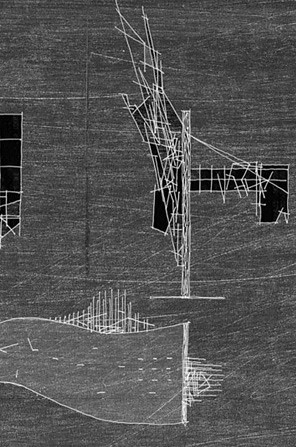
[Image: Lebbeus Woods, The Wall Game, (2004) - A Dialogical Architecture Game.)
Lebbeus Woods’ “The Wall Game” (an essay originally written for Against the Wall, but since he has posted drawings to his website) addresses this pinch precisely of intending well enough to use design somehow to find a way of renegotiating the wall, or to programmatically dismantle it by working with it directly, but recognizing the greater limitation of the wall context: to accept the wall on any level would only doom his intervention to show support for it in the end. The paradox being: you can’t reconcile perhaps what cannot be reconciled; you can’t make something (the wall) humanitarian when it is intrinsically anti-humanitarian. Lebbeus’ response was to make a game out of dismantling the wall that both Israel and Palestine would play, a delicate balancing act of subtracting pieces from it while trying to keep it balancing in place without toppling over. A brilliant metaphor for the real game both sides play politically in keeping the wall in tact held up by mutual fear. Needless to say, I was eager to lob in a few bits of my own tangential thinking for whatever they were worth.
Thanks to the good ol’e blogosphere Ron created a nice archive of the studio. I have more to say about the studio in general and some of these projects in future posts here on Subtopia, partly because I think his studio presents a critical dialogue for architects to ponder when addressing the border, raising important ethical questions about the designer’s role in national security and participating in the politics of border space production and immigration, which -- in my view -- cannot be easily sidestepped by virtue design might be able to make an impact, or because there is a design potential in everything (including a border fence) that makes it worth exploring.
In some ways I worry the deeper more challenging political concerns can be too easily sacrificed by what has a tendency to become a design for design’s own sake kind of architectural exercise. Not to say this type of practice doesn’t have value, or that Ron’s studio falls into this trap. I just personally feel any project along a zone of conflict like the US-Mexico border needs not only to be carefully imagined but (above all) primarily locally driven – otherwise it risks being another act of grandiose superimposition. The architect not only looks like a stooge for state power but all too desperate to use the border as a means of reminding themselves of their own sense of authority. As if architecture must have a say in resolving everything.
But, more on that trail of thought later.

[Image: A Practice in Excavating and Envisioning Ambos Nogales, by Edwin Agudelo, 2008, UC Berkeley, Dept.of Arch. / US-Mexico Border Wall as Architecture.]
One project in particular that stood out after Nick Sowers first mentioned it to me, and once it came to light online, was Edwin Agudelo’s gritty spatial investigation of the border tunnels in Nogales. Like myself, he shares a fascination with the tunnels as unique spaces situated in a very precarious but extremely interesting political context. The architectural implication of this niche is loaded because, like a wall, the tunnels reflect the very inherent colonial nature of architecture. In fact they go a step further and drive at a far more interesting dimension: the subversion of architecture’s power in the wall. (For now, I have my own doubts in this regard about claiming the tunnels as architecture, and kind of think that the tunnels for this reason should remain permanently outside the scope of architecture – but I may reverse that by the very end of this post, so hold all thoughts.)

[Image: A Practice in Excavating and Envisioning Ambos Nogales, by Edwin Agudelo, 2008, UC Berkeley, Dept.of Arch. / US-Mexico Border Wall as Architecture.]
For his project A Practice in Excavating and Envisioning Ambos Nogales (still in development) he sees the tunnels offering new buried realms of architectural possibility, and described it this way:
My interest was in locating, excavating and envisioning three underground border systems: infrastructure (sewage tunnels), natural systems (caves), and illicitly dug tunnels, which through a system of aggregation, might suggest a specific spatial dynamic capable of being programmed for public access. Much of the potential for me exists within what I feel is the futility of the border fence as a definitive and defensible measure. Part of this dynamic is already visible at the border fence in the form of breaches that occur on a daily basis.
Of course, the tunnels are already serving numerous possibilities as we speak piping drugs and people across the border, water and oxygen, cash, weapons, rats, streams of piss, electric cables, newborn babies, mining carts and tracks, information, surveillance feeds, history, politics – who knows what else – (take away the illegality of drugs and cross border migration and these spaces would not even exist; they are by definition anti-public.) but Edwin’s approach to examining the wall’s latent potential as an architecture is to harness these spaces of subversion and (goes without saying) we here at Camp Subtopia dig that a lot: not just for its architectural fantasy but simply because it suggests something more important: the wall’s greatest utility to humanity is perhaps its own misgiving of itself. Thanks to the wall’s self-defeating nature we have new tunnel space to consider. How could we catalyze the tunnels’ extraction in space and time, reinvent this unraveling of the wall in the form of tunnels, and what purpose could they serve in engineering new connections to public space?

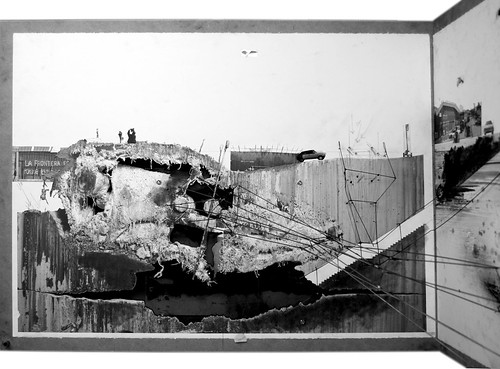

[Image: A Practice in Excavating and Envisioning Ambos Nogales, by Edwin Agudelo, 2008, UC Berkeley, Dept.of Arch. / US-Mexico Border Wall as Architecture.]
As I see them, the tunnels are among the most adaptive and evolutionary typology in the realm of spatial politics; they’re a kind of liquid landscape capable of circumnavigating anything. Through out history they’ve saved people, defended national sovereignties, some have allowed people to escape immanent torture while others have led to abduction. They've been sites of war, refuge, passage, storage, economy, housing, criminality, you name it. They’ve served humanity for as many noble purposes as they have suspect. Today, where border porosity and fluidity are limited the very nature of tunnels gets at the profound violence of architecture via its own decolonization. Architecture is a wall before it is a tunnel. Architecture as an island of territoriality. (There is poetic justice in there, I tell ya). To harness the tunnels for another use as an architectural prospect is certainly a very curious notion but I’m not yet sure they really belong anywhere else but in their own context right now.
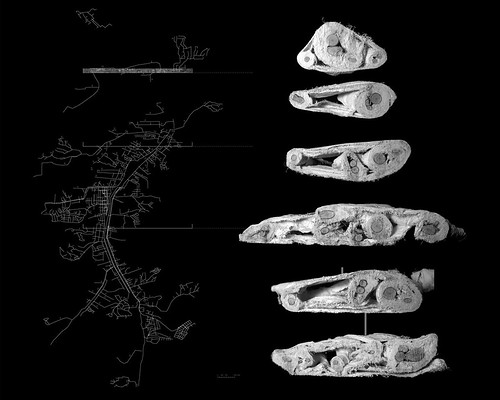
[Image: A Practice in Excavating and Envisioning Ambos Nogales, by Edwin Agudelo, 2008, UC Berkeley, Dept.of Arch. / US-Mexico Border Wall as Architecture.]
Believe me, no one finds them more fascinating than I do, and my first reaction is to believe there is experimental potential in the tunnels, as Edwin’s project explores in a very cool – and in his own right – methodological sort of way. He made his own molds of border voids, sculpted scaffoldings with wires that depict shapes and supports for the tunnels, his project is awesome and I just love the dark salvaged organic style of his underworld cross-section; some of his images remind me almost of a sonogram, or dissections of pregnant landscape voids, or something. I think his approach to this project captured some of the essence of these tunnels.

[Image: A Practice in Excavating and Envisioning Ambos Nogales, by Edwin Agudelo, 2008, UC Berkeley, Dept.of Arch. / US-Mexico Border Wall as Architecture.]
Their mystery is undeniable, that’s for sure. As spaces of illicit economy, violent cartel turf wars, international trespass, they offer their own notorious appeal to our spatial imaginations. But, I’m also reminded of a very simple and weighty point made by Matthew Coolidge at Postopolis! when he said, we can’t have a city without leaving something in the earth beneath it, a dump, a toxic site, a refinery, etc. The city is inextricably bound to the earth. And, I think about these tunnels in this way, how they are also left in the ground by the city, by the city’s very idea of itself these day, its proverbial fences, its fiendish culture, its retrograde laws, uneven capitalist development, its failed policy and theatrical borders. The tunnels as footprint of a global city that cannot be seen. Ghost cities of transnational capital - the tunnels as hard phsyical entrails of network infrastructure's global legacy. Smuggler urbanism.
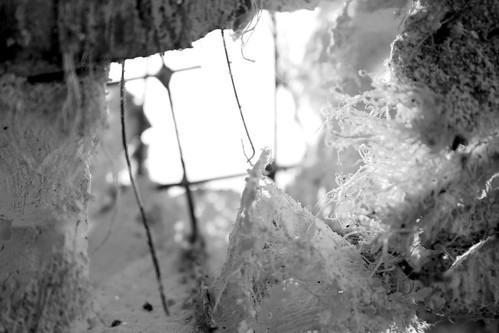
[Image: A Practice in Excavating and Envisioning Ambos Nogales, by Edwin Agudelo, 2008, UC Berkeley, Dept.of Arch. / US-Mexico Border Wall as Architecture.]
As fossils of superpower’s erosion the tunnels are rich with political reflection, while spatially it’s easy to wonder whether they could serve as a kind of blueprint for something else, or as residue, examples of something that cannot normally be planned or integrated. Could these tunnels enable something not otherwise able to happen, spawn some sort of critical integration, critical linkages to social justice, new reflective public space? However, reusing them seems like the same desire of trying to frame a magical stroke of wind or capture light inside a bottle. Unless we were to think more whimsically, like turning them into great earthen windpipes that could be used to musically perform measurements of climate change, or breathing valves for a larger hydroskeletal system of some sorts. Could they be observation platforms for studying something else, ways of magnifying twin cities lit from underneath; there is a history of tunnels these need to be compared with, etc.? Though, I wonder if, more likely, they’re not destined to the same types of tunnel museums or tourist sites we find in the ancient sites of Turkey, or in Vietnam, or the preserved escape hatches left below Bosnia, for example.
Aside from their fertile speculation, what remains most interesting about the tunnels to me is the fact they’re illegal, like fleeting acts of architecture; architecture as political act in its crudest form. Though, I fear, the moment they become permanent, or made more formally viable or "social" they will lose a certain relativity that makes them less interesting as spaces. In other words, I kind of see them not spaces as much as they are spatial processes. I share Edwin’s enthusiasm about these voids leaving us with interesting products in the end to consider reusing, but it is their qualities as an emergent phenomenon I think that distinguishes them. They are morphological and temporary, made in response to something else. They infiltrate, squat, permeate, deviate, crumble, they self-destruct, they are canonized, forgotten, lost, fought over, and are fundamentally at war with their own exposure. To take that (in)visible element away from them might make the border tunnel something else entirely, like just a series of wormholes in the ground.
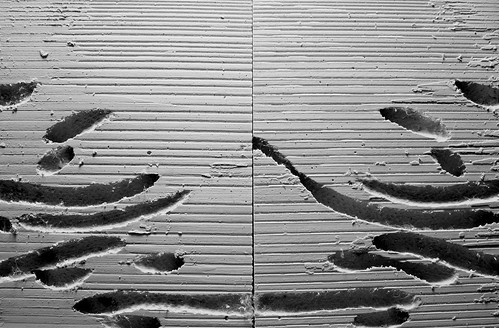
[Image: A Practice in Excavating and Envisioning Ambos Nogales, by Edwin Agudelo, 2008, UC Berkeley, Dept.of Arch. / US-Mexico Border Wall as Architecture.]
A few more questions come to mind:
If the tunnels were to be preserved for public use then ideally for what purpose? Shouldn't they respond to larger issues like the pervasive commodification of space by elaborating something that has nothing to do with capitalistic flows? Shouldn't they enable a thriving underworld of experimental cultural space that remains attached in a serious way to the socio-cultural origins of the tunnels and the political struggles that first engendered them? I am thinking more about the migration realities of the tunnels than their smuggler connotations, and how they have come to represent a type of wounded space of forced migration that has had to retreat into the buried ditches of organized crime where violence defines the landscape.
So, to imagine something as lame as an entertainment corridor, or even a funky underground art space seems to me too commercial and disengaged with the context and misses the point. I would think, to seriously adopt these tunnels the project would need to be in large about showing respect for the migrants who have come through them, who have died in them, honoring this journey in some regard, this motion; of those who have symbolically been born or reborn inside them, have had their identities traded and transferred through them, the new tunnel project would nurture their struggle, dignify it without martyring it, bring some sense of acknowledgment and respect to their plight. The tunnels would be about preserving dignity, in my view.

[Image: A Practice in Excavating and Envisioning Ambos Nogales, by Edwin Agudelo, 2008, UC Berkeley, Dept.of Arch. / US-Mexico Border Wall as Architecture.]
Edwin spoke to me about his interest in marking this natural shift from the above ground to below ground as meriting further architectural wonder. He asks, “If this sort of circus can exist above ground (the wall’s futility and its subversions), then what sort of worlds might we find if we could have a totalizing view of the underground?”
Well, Richard Marosi’s article provides one very clear picture of that, but rather than lifting the rock and finding worlds, what worlds could we create? I would add, since this shift has already forced migration to where it is now treacherously below the surface – to restabilize the tunnels would, for me, be for the purpose of weighting and reshifting the corridors of migration back to where they belong, in the open passable space on the border’s surface. To slap a hipster cross-border saloon/exhibition space in there might be cool, but might be an exploitation of this dark sphere of migration in the end, reducing the tunnels to idle gringo fetish.
So maybe a tunnel preservation project would help sanction migration in the open where it belongs. An immigration museum even seems generic at this point, but maybe more realistic. Maybe the tunnels become occupied by squatters who form a legal advisory group that counsels divided families on their rights, or provides a sanctuary meeting place buried in the earth across the Texan border near Juarez; maybe it extends humanitarian aid through some type of spatial neutrality. Maybe, the tunnels are just left alone and become a natural archive, a repository of lost autiobiographies and hidden memorials. Or, we could make them sort of like the Islands of LA and conserve them as bi-nationally owned public parks – anyone want to have a picnic with me in an old sewage shaft? Maybe they’re used as an ecological vault – we hatch evolutionary algae-powered ecosystems in them that could have some revolutionary effect on powering a border economy. Of course, you could just host architecture studios inside them as well to ponder new interfaces for urban futures migrating underground. Hell, my ailing back tells me to put an anti-Bikrum yoga class in there. Farfetched, but you get the idea.
I guess I’m not yet sold on prospecting the tunnels as something disconnected from their rooted pasts. Writing about Gaza’s tunnels along Israel’s border that have been discovered and filled with concrete by the IDF over the years, Eyal Weizman writes in his book Hollow Land, “If ever uncovered, years from now, and craned out, the frozen network of concreted tunnels, a solidification of complex subterranean movement, would appear like bouquets of giant corals.”
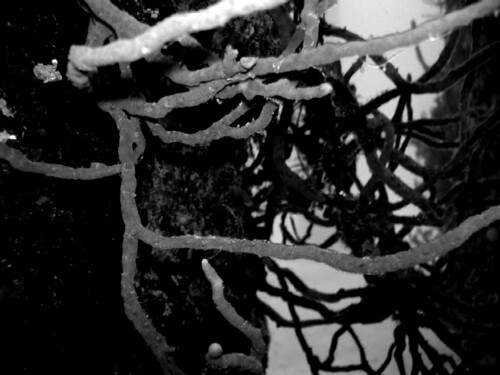
[Image: Atlantic Coral Reef (via).]
This gets back to Edwin’s sense of shift and to an idea I’ve had for years around these tunnels – something I was going to propose for the next inSite gathering. Tell me if this is just an awful proposal for an installation.
Before the 7 largest tunnels found along the US-Mexico border were plugged a couple of years ago, I would have modeled their dimensions with GPS in a 3D environment to then build full scale replicas of the tunnels on the ground using simple wood frame-supported tubes packed with mud, and then lay them over the US-Mexico border in various locations so attendants could actually cross the border by drudging through them. Inside, the tunnels would have audio recordings, short documentary videos, scribbled maps, cryptic markings, photos and artifacts of migrants who’ve come through the tunnels. It would be a narrative of their passage.
Now, you could cram this experience inside the real tunnels as Edwin might want to explore, but again I see this as a sort of pendulum that might try swinging immigration justice back to the surface. Maybe harnessing the real tunnels would do that, I don’t know. But, I wouldn’t just want to create another surreal tourist simulation of border crossing, it would be more contemplative. After, we would break the tunnels up into smaller pieces that would be shipped off to sites around the world, in cafes, malls, galleries, bars, on streets. I don't know...
I’m also very interested in topsoil as interface (the tunnel mouths as emergent perforations in capital’s crisis); will future urbanism reside somewhere in these nodes of passage between city surface and the labyrinthine footprint harboring beneath it? Instead of spending half our lives inside a car on LA’s freeways, you spend it meandering in and out of this weave of skims above and below the surface, bobbing through our lives like urban sea creatures bound to layers of space around the surface of the city.
It’s strange because now I can’t find my own reference, but – one other thing I wanted to quickly note – I thought I recalled back in 2006 when the Border Tunnel Prevention Act was first being floated around before it was signed into law by Congress in 2006 (though, other sources suggest it was never signed into law but just fell off the books…I’m a little confused) there being some language alluding to not only the “construction” of a tunnel being against the law but also including anyone involved in their design, implying a person could be prosecuted for planning to construct an illegal border tunnel without having to actually build one.
Of course, when I go to look this up I find only very short and clear legal verbiage on two points: you cannot construct a border tunnel, nor can you allow someone knowingly to construct an illegal border passage on your property. It mentions nothing (as I originally thought it did) about criminalizing the theoretical design of tunnels. This aspect always fascinated me though because as someone who researches these and has tried to imagine them on paper I was always curious to what degree drawings of border tunnels could be considered a criminal act. It seemed too ambiguous and controversial territory for a law to try and assert authority, but if I remember reacting at the time correctly to reading what I still think I read the language in this regard almost seemed left purposefully vague, and so I was very anxious to see how the government would one day try to prosecute someone for having drawings or schematics (sadly, what if that meant architectural student projects, or avante guard sculptures that looked like in some DHS administrator’s eyes like a secret plan to build tunnels). I thought it was unsettling the government put in some language that would blur the lines of what could be construed as plans for illegal border tunnels. Hopefully, a case like that never transpires.
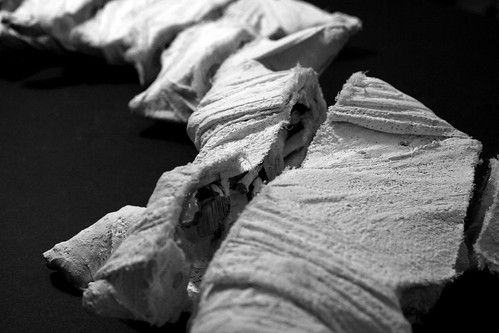
[Image: A Practice in Excavating and Envisioning Ambos Nogales, by Edwin Agudelo, 2008, UC Berkeley, Dept.of Arch. / US-Mexico Border Wall as Architecture.]
Anyway, the idea that Edwin’s project was situating itself on some sort of legal interpretive fringe this way made it all the more relevant and exciting, in a way honoring the territorial interrogation of the tunnels themselves, and I was super happy to see that someone else was considering the border tunnels in such a way, in a design project nonetheless that not only might challenge this notion of the Border Tunnel Prevention Act in an absurd way, but force people to rethink what the conduits of global migration should really look like, and how the pathways of these flows could be seen in a more dignified light? I’m still very curious about whether I just imaged this or if the law did at one point mention something more explicitly about the planning of illegal tunnels. I need to get to the bottom of that.
Anyway, I think Edwin's images are amazing and can't wait to see where he takes this next.
[Tunnelizing Migration 2 (coming)]
See Tunnelizing Migration 1: The Border Tunnel Capital of North America; Tunnelizing Migration 3: From Headwalls to Super Walls; Orwellian Wormholes.







3 Comments:
The issue of making destruction palatable, and therefore potentially easier to get away with, was discussed in some of the later writings of Robert Smithson. He had proposed the creation of earthworks in mining sites and other damaged landscapes, but he realized that calling the damaged site "art" might allow the owner to avoid more costly reclamation and repair. Glossing over the border wall with more superficially "humane" architecture runs a similar risk - it becomes more palatable, and therefore it is easier to construct more walls without addressing the impacts on communities, environments, or the thousands who have died crossing the deserts and mountains to get around them.
Amazing images and provocative commentary, read in the context of spending 2hrs a day in the tunnels of NYC, many built by speculators of the early 20th century looking to undermine(!) the competition, and they remain fairly full of high-spirited public interactions (though this is changing with the onset of cell-phone reception and security cameras)...
The dilemma seems to be: the border tunnels have relevance only as long as the border exists (in its full three-dimensional spatial quality of air, land, and personage control), but should/when the border disappears as a construct, the "artifacts" of walls, tunnels, and the occasional grave will be swamped by the flood of mega-sprawl exploding from the north and south. And to the degree that this sprawl is unsentimental and without the pretense/complications of Design (the hybrid sprawl of SoCal/TJ, the Calexico/Mexicali metroplex as prototype) it, along with work such as Agudelo's and the full-scale reproductions based on 3D scans may be the best we can hope for...
Which brings me back to underground NYC and the Viele map of Manhattan: drawn in 1865, showing the original watercourses of the city, and referred to today whenever one does sub-grade work. A similar map of the border tunnels must exist somewhere, and it would be a gas if it had an online presence that was periodically updated by the trafficers as they abandon certain areas...
very nice post, well put argument and still opens up more venues for exploring through the critique. It is good that this excercise which according to me is an amplified form of the design practise at a metaphorical level, makes students understand the dilemma of a funded design intervention in capitalist form of producing space.
Post a Comment
<< Home